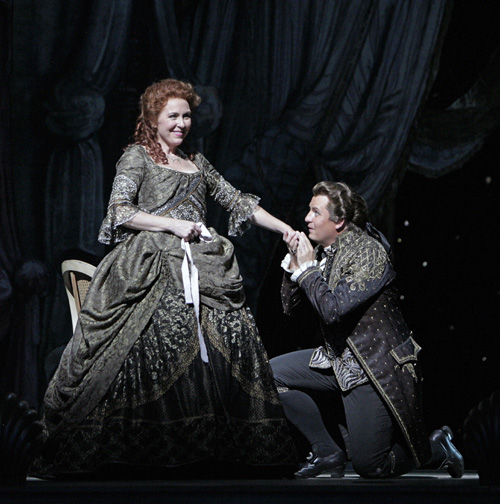 The enduring charm of singing Mozart
The enduring charm of singing Mozart
To an ear accustomed to contemporary World Music with its wide-ranging discography from recordings of villagers in Balkans to slickly produced fusions of Ry Cooder and Ali Farka Touré, Mozart’s Abduction from the Seraglio hardly seems to incorporate the Turkish sound claimed. It’s there, sort of, in the percussion, flutes and high piping piccolo, but for the most part the music is Mozart—decorous, melodic and thoroughly charming. Adjectives that characterize the current superb production of The Abduction now at San Francisco Opera.
Led by the 29-year-old German conductor Cornelius Meister in his U.S. opera debut, the Opera’s orchestra projected all the clarity and delicacy needed for Mozart, maintaining a rhythmic precision over which the singers could float their radiant voices.
Tenor Matthew Polenzani, who sang Belmonte, the Spanish nobleman come to whisk away his true love from the harem of a Turkish pasha, was at the forefront of those voices, with a masculine beauty that retained its grace throughout the singer’s shifts in vocal dynamics and remained effortless throughout. Polenzani has the requisite stage presence—gallant, restrained and slightly abstract—to match his fine voice.
Constanze, Belmonte’s lady love, was sung by Mary Dunleavy, who indeed has a beautiful and pleasing voice, tonally warm and necessarily flexible; though her energy seemed to flag at the end of “Marten aller Arten.” I’ll concede my sense of fading energy may have been me, though, wilting under some 8 minutes unrelentingly exquisite ornamentation.
Soprano Anna Christy sang the enviable role of Blonde, Constanze’s sassy maid, with a crystalline purity of intonation capable of immobilizing the listener. She was partnered by Andrew Bidlack, as Pedrillo, who has a similarly beautiful voice but who seemed less substantial on stage, a lapse that will disappear with age and experience.
The ensemble work, duets and quartets, characteristically Mozart’s finest writing, was served up with finesse by this excellent quartet of singers.
An outstanding performer and the clear audience favorite was bass Peter Rose. Formidable in size of body and sound with an additional fineness of tone and a rollickingly funny accent of indeterminate provenance, Rose made the quintessential Osmin, harem security guard, beefcake and brainless dude.
All the world’s a stage
This co-production, with the Lyric Opera of Chicago, used the timeless theater trope of the stage within a stage, one that echoes cinema’s use of historic stage settings, and it resembles the recreation of The Abduction in the movie Amadeus. The world of the Turkish pasha is set in what is meant to be an 18th-century theater, which dominated center- and upstage of the real stage. Storybook waves churn in a toy-like manner in the upstage of the mock stage. A toy ship floats over their blue ridges later to have its prow bump onto the raised boards of the stage. The characters move back and forth between this theater and the real stage.
Set designer David Zinn and director Charles Rader-Shieber’s decision to use this trope places the imaginary land of the Seraglio entirely in the artificial world of the theater and the mind: there’s no mistaking this Middle East for the Islamic one where the United States is currently staging a war. And that’s a good thing. For Mozart’s orientalism is almost 250 years out of date, and it was never a political statement but rather one of fashion, a stylistic titillation basing its appeal on the unknown and the otherness of the exotic. Though the practice in opera today is to entwine the past with the present, this is one opera that best remains clearly in the world of refined and elegant illusion.
—Jaime Robles
Originally published in the Piedmont Post
Photo of Mary Dunleavy as Constanza and Matthew Polizani as Belmonte by Cory Weaver
